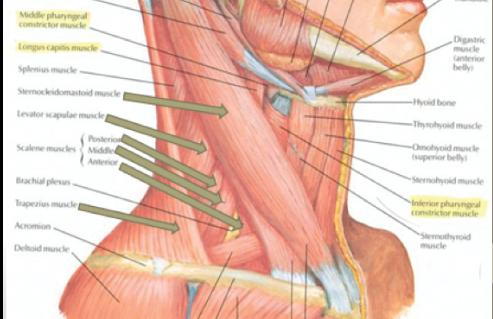Whiplash Injuries Can Cause This Commonly Overlooked Injury

- posted: Jun. 22, 2023
AOMSI Causes Injury To The Nerve Bundles Located Within The Neck Muscles
The cervical ganglia are paravertebral ganglia of the sympathetic nervous system. The bilaterally symmetric sympathetic chain ganglia, also called the paravertebral ganglia, are located just ventral and lateral to the spinal cord. The nerve ganglia (bundle) are located on both sides of the neck within the muscles indicated above.
Upper Nerve Root Ganglia Injury
If the upper roots, C2, C3 and C4, are irritated they may complain of occipital headaches, often typical of migraine, with pain radiating to the eyes and behind the ears, blurring of vision, dizziness and nausea especially when attempting to lie down, numbness of the side of the neck, tension and “knots” in the neck and shoulder muscles, and swelling and stiffness of the fingers.
Middle Nerve Root Ganglia Injury
If the fourth and perhaps the fifth nerve roots are irritated they may complain of shortness of breath, palpitation of the heart, pain in the chest, and localized pain in the muscles between the neck and shoulder joint, or between or about the shoulder blades. Irritation of the fifth nerve root is most common and other symptoms are: pain at the tip of the shoulder, in the middle of the arm, sometimes near the elbow in the extensor muscles of the forearm, and numbness and tingling of the thumb and/or index finger. Stiffness of the shoulder and/or weakness of the arm with inability to comb the hair, fasten a brassiere, or to reach the hip pocket are frequent complaints.
Lower Nerve Root Ganglia Injury
Irritation of the sixth and seventh nerve roots may cause pain in the shoulder, arm, forearm, wrist, chest and numbness and tingling of the index, middle and perhaps the ring fingers.
Summary of Concomitant AOMSI Injuries
This whip-lash type of injury, as described by Ruth Davis, MD, is responsible for the greatest percentage of cervical nerve root irritations. This type of injury is caused by a sudden forceful movement of the neck with subluxation of the articular processes and stretching, tearing, or avulsion of, and varying amounts of hemorrhage into, the ligamentous and capsular structures.
Automobile accidents are responsible for the greatest number
of such injuries.
Jackson R. The cervical syndrome. Dallas Med J. 1949;35:139–146.

- posted: Jun. 22, 2023
AOMSI Causes Injury To The Nerve Bundles Located Within The Neck Muscles
The cervical ganglia are paravertebral ganglia of the sympathetic nervous system. The bilaterally symmetric sympathetic chain ganglia, also called the paravertebral ganglia, are located just ventral and lateral to the spinal cord. The nerve ganglia (bundle) are located on both sides of the neck within the muscles indicated above.
Upper Nerve Root Ganglia Injury
If the upper roots, C2, C3 and C4, are irritated they may complain of occipital headaches, often typical of migraine, with pain radiating to the eyes and behind the ears, blurring of vision, dizziness and nausea especially when attempting to lie down, numbness of the side of the neck, tension and “knots” in the neck and shoulder muscles, and swelling and stiffness of the fingers.
Middle Nerve Root Ganglia Injury
If the fourth and perhaps the fifth nerve roots are irritated they may complain of shortness of breath, palpitation of the heart, pain in the chest, and localized pain in the muscles between the neck and shoulder joint, or between or about the shoulder blades. Irritation of the fifth nerve root is most common and other symptoms are: pain at the tip of the shoulder, in the middle of the arm, sometimes near the elbow in the extensor muscles of the forearm, and numbness and tingling of the thumb and/or index finger. Stiffness of the shoulder and/or weakness of the arm with inability to comb the hair, fasten a brassiere, or to reach the hip pocket are frequent complaints.
Lower Nerve Root Ganglia Injury
Irritation of the sixth and seventh nerve roots may cause pain in the shoulder, arm, forearm, wrist, chest and numbness and tingling of the index, middle and perhaps the ring fingers.
Summary of Concomitant AOMSI Injuries
This whip-lash type of injury, as described by Ruth Davis, MD, is responsible for the greatest percentage of cervical nerve root irritations. This type of injury is caused by a sudden forceful movement of the neck with subluxation of the articular processes and stretching, tearing, or avulsion of, and varying amounts of hemorrhage into, the ligamentous and capsular structures.
Automobile accidents are responsible for the greatest number
of such injuries.
Jackson R. The cervical syndrome. Dallas Med J. 1949;35:139–146.
Visit our Office
Office Hours
Monday
8:30 am - 12:30 pm
2:00 pm - 6:00 pm
Tuesday
8:30 am - 12:30 pm
2:00 pm - 6:00 pm
Wednesday
8:30 am - 12:30 pm
2:00 pm - 6:00 pm
Thursday
8:30 am - 12:30 pm
2:00 pm - 6:00 pm
Friday
8:30 am - 12:30 pm
Saturday
By appointment only
Sunday
Closed

